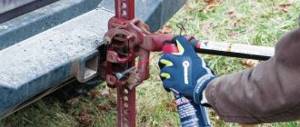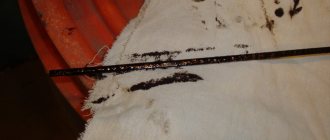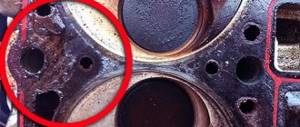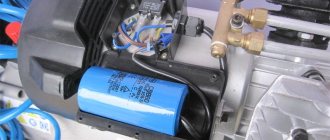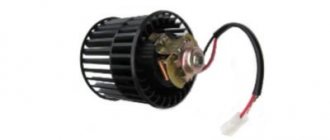Sometimes problems arise with hydraulic jacks. Most people throw them away immediately. But don’t throw it away, maybe the problem isn’t that big.
But it happens that the jack does not raise it to the required height. Previously, for example, the length of the rod was enough to lift the car, but now it is not. It rises halfway and that’s it. Oil is to blame here. More precisely, its lack.
When a working jack works, oil is still consumed. Quite a bit, but it is used up with each rise/fall. For good reason, it should be changed from time to time - about once a year. But who does this kind of nonsense here?) Usually it works as long as it works)
In general, two of my jacks malfunctioned. One is rolling, the other is bottle-type, both are hydraulic, of course. A rolling jack is the same as a bottle jack, only installed in a special design. After I raised the car, they slowly lowered it. I decided to add oil.
In general, it is recommended to add special hydraulic oils to such jacks. You can go and buy it, you can fill it with spindle oil, which is also hydraulic. Or you can, at your own peril and risk, top up with regular engine fuel. Which is what I did. This, of course, is not recommended, the properties of the oil are not the same, but oh well
.
First you need to lower the jack completely. We unscrew the fitting, lower the rod (or the lifting part of the rolling part), and screw the fitting back. We find the hole through which the oil is poured. It is closed with a rubber plug.
Reading time: 5 minutes
There are many types of lifting mechanisms, the most common among car enthusiasts is the hydraulic type of jacks (bottle, rolling). If improperly maintained, jacks can fail, for example, they stop lifting loads. And the question immediately arises of what to do if the hydraulic jack does not lift. You don’t have to buy a new one right away; there is always a way out; often everything can be fixed by performing maintenance on the unit.
Briefly about the main faults
- Stop. Occurs due to the lack of liquid in the chamber or the presence of contaminants in the oil.
- Insufficient lift height. Occurs due to a limited amount of working fluid.
- Slow rise, jerks. Explained by the presence of air, as well as a possible leak in the hydraulic system.
- Reduced pressure. The valve needs to be diagnosed or replaced. In this case, the jack also stops holding, lifting completely, springing, and can lower the load on its own.
Most often on forums you can find complaints that the hydraulic jack does not lift.
Design and principle of operation
The design of hydraulic jacks is approximately similar to both rolling and bottle jacks. Main parts of rolling devices:
- piston;
- lever arm;
- stock;
- suction valve;
- stop valve;
- oil reservoir;
- working cavity.
When the handle is lifted up, the shut-off valve is activated, and oil enters the chamber due to the operation of the suction valve. By pumping oil from the reservoir into the cavity of the working cylinder, the piston is raised. Next, to lower the piston with the rod, the bypass valve opens, then under the pressure of the load the piston will lower.
DIY hydraulic jack maintenance and repair
To know how to repair this device, you need to study its structure and operating principle. The cross-sectional diagram is shown in the figure:
The working cylinder (4) is tightly screwed into the powerful base (10).
The connection must be reliable, since the pressure of the working fluid (6) when lifting heavy objects is quite high.
A working piston (5) with a sealing ring is placed in the cylinder. An extension screw (3) is screwed into the working piston (also known as the lifting rod), which, if necessary, is unscrewed by 2/3 of the length of the rod.
The screw ends with a support platform (7), which has anti-slip corrugation.
Around the working cylinder there is a protective casing (2), which serves as a container for the working fluid (6).
Nearby there is a pressure cylinder (plunger) (8), hermetically screwed into the base.
It is equipped with two valves. The intake valve, when the pressure piston moves upward (9), fills the cylinder with working fluid.
When the injection piston is lowered, the liquid enters the working cylinder through the supply valve and presses from below on the working piston (5).
Under pressure, the rod moves upward, lifting the load. The cycle is then repeated until the required lift height is reached.
At the end of the work, the bypass valve (1) opens, and the liquid from the working cylinder (4) flows into the container body (2).
The valve has a ball valve that can withstand high pressure. The working piston lowers under the weight of the load, displacing all the liquid into the container.
Read also: Vertical drilling machine 2s132 technical characteristics
The jack is ready for the next lifting cycle.
Why won't the jack go down or up?
Reasons why the jack refuses to work:
- Cylinder failure. The working plane does not support the load; as a result, liquid flows from the cavity into the space above the piston.
- Damage to the mirror. Hydraulics lose efficiency or simply fail, this occurs due to improper transportation, it can lead to oil leakage and air entering the chamber, in which case corrosion will certainly begin over time.
- Corrosion. Leads to rapid wear of the cuffs and seals, which may result in dirt getting into the liquid and clogging the channels and valves.
- Unit fall. The greater the height from which the jack falls, the more serious the deformation of parts and main components can be.
- Too much load. Causes the rod to bend. This leads to misalignment of the main components and oil leakage.
- Use of the device for purposes other than its intended purpose, as well as failure to change the oil in a timely manner.
Troubleshooting Methods
Oil leakage is the main problem, due to which the rolling jack does not lift completely (if the leak is small) or at all (if the leak is significant). Because of this, air enters the cavity, and then the hydraulic jack works with little force or refuses to work at all. Leaks in the hydraulic system can be prevented by routine maintenance and checking the oil level. If the level is low, you just need to add fluid to the normal level.
Due to lack of fluid, air leaks into the hydraulics. This problem is solved by bleeding: you need to unscrew the cap of the oil tank and the bypass valve, and then simply pump the system, that is, move the lever up and down until the liquid passes into the main cylinder.
Often the cause of hydraulic jack malfunction is corrosion on the pistons, rods and cavity of the unit. To determine the cause in detail and repair it, you will have to disassemble the device.
A bent rod is also a common reason why a rolling jack does not lift or operates jerkily. In this case, you can change this element by taking an analogue from the old model, or purchase a new part. In most cases, such a malfunction cannot be repaired at all, even in a workshop or service center. This is explained by the fact that the rod usually bends under shock loads, and in this case the main elements of the housing are damaged. In this option, it is cheaper to purchase a new unit without having to restore or replace individual parts.
When the bypass valve becomes deformed or dirt simply accumulates in it, the valve ball sits tightly in the seat and hydraulic fluid leaks through it. In this case, you will simply have to replace it and replace the old (contaminated) oil with new one.
The main causes of hydraulic jack malfunctions and how to eliminate them
Jack repair diagram.
One of the most common causes of jack failure is oil leakage. As a result, air enters the working chamber, and as a result, the lifting mechanism does not work at full capacity or stops functioning.
This problem can be avoided by periodically performing maintenance on the hydraulic jack, which consists of monitoring the amount of fluid and, if necessary, adding it to the working cylinder. A decrease in the amount of oil in the system can be a consequence of natural operational loss, as well as due to damaged or faulty oil seals and seals. In this case, simply adding fluid will not solve the problem; it will be necessary to replace the failed seals and seals.
Due to the lack of working fluid in the system, air takes its place - this can be guessed by the reduced efficiency of the jack. You can get rid of this problem by pumping. To do this, open the oil tank cap and the bypass valve and bleed the hydraulic pump. If this is the fault, then if this work is performed correctly, the jack will be in working order again. But if this does not help, then either the cause of the malfunction is different, or more serious repairs will be required. Sometimes this problem can be solved by unscrewing the locking needle two turns, at the same time raising the piston to the top point, and then releasing it so that it reaches the bottom. This action must be repeated 2-4 times.
If corrosion or damage to parts is detected, they are replaced.
Often, the cause of incorrect operation of a hydraulic jack can be corrosion that affects the retractable pistons (rods or plungers) and the inside of the housing. But to find out the reason, you will need to disassemble the device. To do this, you can contact service workshops or do the work yourself. You will need a set of keys, a repair kit, a container for draining old oil and a canister with new oil to fill the system after repair.
A bent rod also often causes the jack to fail; in this case, if provided for by the design features of the model, it can be replaced with a new one, and often this means that the jack cannot be repaired even in a service workshop.
Dirt can be removed by washing it with kerosene. The bypass valve can also quite often be the culprit. It may have some deformation or dirt may have gotten into it, causing the ball to not sit tightly in the seat and therefore leaking fluid. This problem is solved mainly radically - by replacing the bypass valve.
Fault Detection
The rod extends to the desired height, but then slowly (without load) lowers - in this case, the reason is most likely in the bypass valve and damaged o-rings, so the required pressure is not maintained.
If the rolling jack does not lift to the end, it means that the working stroke has decreased. At this point, the culprit is the corrosion that has formed on the rod and the surface of the cylinder. If the load being lifted is greater than the lifting capacity of the jack (indicated in the passport and on the body in tons), then there is a possibility of damage to the rod and its bending.
In order for the jack to serve for a long time and not break, you must remember the following rules:
- Hydraulic fluid replacement is necessary 2 times a year.
- If the lifting device is used every day, the hydraulic fluid should be changed monthly.
- In extreme cases, any hydraulic fluid can be used, but in winter it is recommended to use synthetic oils specified by the device manufacturer.
- To prevent the oil from thickening in winter, it is necessary to store the jack in a dry, warm place.
- It is not recommended to use the jack in the cold in winter, because it may simply stop working.
To fix a breakdown, you can lose a lot of time and money, so it’s easier to follow the operating instructions for a hydraulic jack, and then it will last a long time and will help lift the load more than once.
How does a hydraulic jack work?
To accurately determine the cause of the breakdown and its subsequent elimination, you should have a clear understanding of the operating principle of the device. Fortunately, hydraulic jacks are quite simple, and most of their problems can be fixed on your own. Contacting service may be necessary in cases of serious defects or a complete lack of desire to read the repair instructions. The foundations for understanding the operation of the device should be laid by analyzing the main components of its mechanism.
Before describing the functional elements, it is worth noting that hydraulic jacks have several subtypes and are divided into rolling, bottle and diamond-shaped. The classic type of liquid lifting mechanism is most closely related to the bottle type, which includes devices with a telescopic, hollow, hook-on and standard rod. To form a correct basic idea, we will analyze the original model without additional modifications. So, a hydraulic bottle jack consists of the following components:
- Body base
. Support platform for installing the device on a flat surface. - Frame
. The outer part of the hydraulic jack and, in combination, the oil reservoir. - Plunger cylinder
. A sealed chamber where fluid pressure is created, pushing the rod out. - Working plunger
. A retractable element with a stop at the end. - Oil filling hole
. Located in the upper, side part of the device body. - Screw
. Retractable element to increase the lifting height of the jack. Screws into the plunger. - Housing head
. A threaded connection that fixes the position of the body in relation to the cylinder. - Sealing ring
. Provides sealing of the oil reservoir, preventing fluid leakage. - Screw nut
. The upper part of the housing head has six edges for easy unscrewing. - Earring
. A convenient element for manual transportation of the jack. Not available on all models. - Screw head
. The end part of the rod that rests on the load. - Lever arm
. A removable element of the hand pump that increases the impact force several times. In most cases, it includes a special groove for unscrewing the shut-off valve (more on that later). - Discharge plunger
. The main element of the pump, driven by a lever. Pumps liquid from one reservoir to another. - Pump cylinder
. Sealed chamber and intermediate link in pumping oil between tanks. - Stop valve
. Serves to integrate/isolate the oil reservoir with the plunger cylinder. - Suction valve
. Regulates the movement of fluid inside the device, allowing it to flow in only one direction (only towards suction into the pump cylinder). - Bypass valve
. The opposite of suction. Allows the pump plunger to squeeze oil out through itself, but does not let it back in.
Repair of rolling jack
Without a jack, a car enthusiast, without exaggeration, is left “without hands.” And it is needed not only to change a tire on the road. A good jack is indispensable for some types of repair work - especially in a regular garage that is not equipped with a lift. For example, when assembling the suspension after repair, when it is necessary to make the final tightening of the levers. There is absolutely no need to lower the car onto the wheels so that the silent blocks take the “working” position - just jack up the lever to give it the desired position. A rolling hydraulic jack is especially convenient - thanks to its design, it can be installed under a part located low - so that no other jack can get under it. But, like any other mechanism, the jack can fail. Repair of a rolling jack is available to anyone who repairs a car themselves. We’ll just tell you what you need to pay attention to first when repairing a rolling jack with your own hands. First of all, let's look at its device.
Jack operating diagram
Diagram of operation of a hydraulic jack
Professional rolling jacks differ in size and load capacity. As a rule, the valve is controlled by turning the handle, which is very convenient during operation. But the principle of operation of all hydraulic jacks is the same, so it is more convenient to use the diagram - after all, despite the size and type of products, they have the same causes of breakdowns.
Rolling jacks differ in size and load capacity. Typically, the valve is controlled by turning the handle.
The force created by the plunger is transmitted through the oil used as the working fluid to the piston connected to the rod. In this case, oil is pumped from the front cavity of the jack cylinder to the rear cavity (from the plunger side). The bypass channel is closed, and the inlet and discharge valves allow the oil to move only towards the rear cavity, that is, the jack works like a pump. When the bypass needle (which is a pointed threaded rod) is opened, oil can flow back into the front cavity through the bypass channel. If at this moment the jack is under load, the piston rod will sink into the cylinder. The performance of the jack is ensured by compliance with three conditions:
- Tight fit of valves to seats.
- Required oil level.
- No air bubbles in the oil.
Design, features of using a bottle jack
The illustration shows what components a hydraulic lift consists of.
The entire structure fits inside a reservoir with working fluid. The lifting rod in the lower position is completely recessed into the housing. The lever handle is removable and does not take up much space in the transport position. Therefore, jacks of this type easily fit in the trunk of a car.
The device, capable of lifting a solid SUV (force 5 tons), has dimensions (taking into account the detached handle) no larger than a 0.7 liter bottle of wine. One person can handle such a jack.
- Easy to operate and maintain;
- High efficiency – up to 80%;
- Low force on the working handle;
- Smooth operation due to the use of liquid;
- Ability to control lift height with high accuracy;
- High reliability due to the absence of rotating and rubbing parts;
- Long service life - other than the O-rings, there is nothing to wear out in the bottle jack;
- A good indicator of safety in operation - in the event of a breakdown, a sharp fall of the lifted object or a part of the tool being thrown to the side is excluded;
- Wide range of application possibilities, not limited to use only in cars.
- The height of the jack body is almost equal to the lifting height. This is typical for single-rod designs; telescopic (multi-rod) options do not have this drawback. This feature is partially compensated by a screw that unscrews from the rod - an extension. Due to this disadvantage, the initial lifting height starts from 20-25 cm. This limits the dimensions of the device;
- Slowness. One cycle of operation of the injection pump provides lifting to a low height. The higher the load capacity, the more movements the handle must be made to lift;
- Inability to accurately control the height of the load;
- Work only in a vertical position. In an inclined or horizontal state, air will enter the hydraulic system and it will have to be pumped;
- Large mass of the device, taking into account the working fluid;
- High cost of the product.
To work with low initial heights (for example, low-slung passenger cars), a rolling jack is used. It operates on a lever circuit, and a hydraulic cylinder is used as the driving force, as in a conventional bottle jack.
The rolling jack does not “hold” - how to repair it
Do-it-yourself repair of a rolling hydraulic jack
This is usually due to either a lack of oil in the jack, or damage or contamination of the valves . In the first case, it is enough to add oil to the jack. What kind of oil should I put into a hydraulic rolling jack? There is absolutely no need to look for some special oil for this. Although, if you use the jack all year round, then it is better to fill it with synthetic motor oil - after all, it thickens less in the cold. In some car services, when the turnover gets stuck, they generally fill in the “working off”. But doing this is extremely undesirable - used oil is dirty and contains a large percentage of aggressive sulfur compounds.
How to bleed a hydraulic (bottle) jack since it has stopped lifting and is springing?
I have a hydraulic (bottle) jack from Kuvalda 5 tons, all the liquid was accidentally drained from it. Is the fluid suitable for power steering and should I bleed it at all? Maybe someone can tell me?
- Steering wheel vibration when braking! SOSSSSSSSSSSSSS
- selection of brake discs
- chassis Volkswagen Passat (B3/B4)
- When it's hot, it won't start until you press the gas to the floor, and then you have to turn it for a long time?
- Autotest
- Do you want clear headlight reflectors?
A spindle (spindle hydraulic AU) is poured into hydraulic jacks, so it prevents the formation of an emulsion, protects equipment from wear and corrosion, and has high performance properties.
Look at how a guy repairs a hydraulic jack, everything is very accessible and detailed. And that’s for sure about the spindle, power steering fluid is not suitable, IMHO.
Before pumping: 1. you need to check the valve; to do this, unscrew the valve and check for deformation or dirt getting inside the valve; if the valve is in a faulty state due to mechanical deformation, then it simply needs to be replaced; 2. you need to drain the oil completely; 3. all parts must be washed to remove dirt and oil; 4. Open the oil tank cap and the bypass valve, and then quickly pump the hydraulic press pump several times.
You need to pump it like this, there is a hole on the side of the jack, through it you fill in spindle oil or any hydraulic fluid (not important), then push the piston out all the way using the hydraulics, put the jack on its side with the filling hole up and press in the piston - this should force the air out of the hydraulic cylinder, then, if necessary, add oil and, if necessary, repeat the operation a couple of times.
The rolling jack does not lift
#1 Gromozeka
- VIP Member
- 911 messages
- Car make: Lada 2114
- From: Rostov-on-Don
#2 Samen
- Car make: VW Sharan
- From: Bryansk
Please tell me how to cure it. They gave me a cheap rolling jack. But he doesn’t want to lift the car. It lifts up to a certain point, and then the leg rises and falls to the previous level when pumping with a pump. I understand there is air in the system? Who dealt with this? The valve tightened well.
Probably this certain moment is the maximum height of rise. Or maybe you need to add oil to it.
#3 Gromozeka
- Car make: Lada 2114
- From: Rostov-on-Don
Probably this certain moment is the maximum height of rise. Or maybe you need to add oil to it.
He definitely didn't rise all the way. I tried it without a car and it rises normally to full height. But it doesn’t support the weight of the car.
#4 _Lelik_
- Car make: VAZ-21099
- From: Kaluga
View Garage
#5 Gromozeka
- Car make: Lada 2114
- From: Rostov-on-Don
This means we need to look at the system. Either add oil or check the cuffs and seals. If it is old, the rubber bands could very well become stiff and begin to poison.
he's new. Tell me how to service it?
#6 Radio technician
- Car make: VAZ 21053
- From: Ekaterinburg
Please tell me how to cure it. They gave me a cheap rolling jack. But he doesn’t want to lift the car. It lifts up to a certain point, and then the leg rises and falls to the previous level when pumping with a pump. I understand there is air in the system? Who dealt with this? The valve tightened well.
Keyword given . It’s a pity to throw it away; it’s nice for a person to make hotza. And no one bothered to scratch his turnip and use this tool.
#7 Samen
- Car make: VW Sharan
- From: Bryansk
He definitely didn't rise all the way. I tried it without a car and it rises normally to full height. But it doesn’t support the weight of the car.
Try adding oil.
#8 Gromozeka
- Car make: Lada 2114
- From: Rostov-on-Don
Try adding oil.
I see 2 valves. One is for air, and the second, as I understand it, is for adding oil?
#9 shmelevdenis
- Car make: vaz 2115
- From: tver
Please tell me how to cure it. They gave me a cheap rolling jack. But he doesn’t want to lift the car. It lifts up to a certain point, and then the leg rises and falls to the previous level when pumping with a pump. I understand there is air in the system? Who dealt with this? The valve tightened well.
in my opinion it needs to be bled as you are bleeding the brakes
#10 Went
- Car make: VAZ 21093
- From: Dimitrovgrad
View Garage
#11 RomzesXIII
- Car make: VAZ 2112
- From: shaRashka Podolsk MO
Here's from another forum that might help:
- Gromozeka likes this.
How to bleed a rolling Chinese jack
If the service life of the Chinese rolling jack has come to the end, that is, it can no longer hold the car, then the device can be pumped. This will allow you to avoid spending extra money on new devices. When carrying out work, safety precautions must be observed.
For this purpose, pull out two cotter pins, which serve to lock the lever axis, and remove the lever. When the oil is passed through the piston, the part is carefully pulled out so that the liquid does not hit the face. Then an inspection is carried out inside the device. If the sealing gasket has become unusable, this is due to the ingress of dirt. If there is no new gasket, you can turn the old one over.
You need to pour oil into the piston hole by gently lifting the jack with your hand. Removing the garter spring will make the whole procedure easier. Oil is added when the top point is reached. It is pushed by the piston until its movement becomes tight. If there is no boot in the jack, put it on to prevent dirt from getting into the cylinder. You can use silicone grease when bleeding. At the end, screw the blocking wire.
The rolling jack will work according to the following principle:
- The piston lever will be held tight by the blocking wire.
- The boot will be sandwiched between the lever and the cylinder.
As a result, this will help avoid contamination of the cylinder, which will increase the service life of the mechanism. Raising the device as much as possible will protect your face from getting lubricant from the cylinder.
Mlyn, jack for bleeding
if you do everything correctly, then first buy special oil for jacks (any collective farm is bad), and it has instructions for pumping
Raise the pumping handle up Close the screw (raise position) be sure to jack without load A slight but sharp blow on the pumping handle. The stroke of the handle during impact is not more than ½ HELPS.
Probably screw 3 – for draining/filling oil into the pre-pump chamber, 2 – releasing air from the post-pump chamber, where you actually pump oil by moving the handle, 1 – bypass valve between the chambers. In addition to the lack of oil, there may be a problem with the bypass, which is also indicated by the fact that you are leaking oil from under the 1st screw. Maybe the valve seat is lifted up, maybe the spring is weakened. The brother had some kind of Chinese jack, the bypass was made in the form of a spring with a plastic conical part. When he took it out, it was no longer conical. In general, he picked up a couple of balls, drove one into the valve seat, turning the seat from conical to spherical, changed the balls and all
Read also: Carpenter's table with hand-held circular saw
I’ll add. Based on the above, the bleeding method should be as follows: 1. the jack is folded, unscrew the 3rd screw, pour oil (I don’t know how much, I probably would have filled it to capacity) 2. lift a small load with the jack to the top position, loosen screw 2 and wait until it cools down oil won’t flow, tighten screw 3. fold the jack, do step 1 again and that’s it
There is often information that rolling jacks often stop holding the load after a short time. The same situation happened to me. I decided to change the stub bushings, hung the car, substituted the bars, but did not loosen the jack, as it was holding it before. After a while I looked, and the jack went down without any load. I didn't like it, but oh well. Changed the bushings. You need to put on the wheel. I start to lift the car with a jack, and it immediately lowers. That is, if you pump at a frantic pace, then somehow it still rises, but as soon as you stop, it falls. Somehow I put the wheel on and decided to disassemble the jack. Here's my handsome guy:
I scattered it. I took off the pump, removed the outer casing, took out the rod with the cuff, and then I just went nuts. What do I see on the inside of the cylinder, in which the rubber cuff goes:
You can feel them when you run your finger over them. It is clear that they are made artificially. If the jack is not raised to the maximum height, then the cuff will not reach these scratches, but this is unlikely to happen unless you check its performance in a store when selling it. And here's what happened to the cuff:
How to increase sales of jacks? Yes, it is necessary to artificially limit their service life. Not many will look for the cause of the malfunction and go buy a new one. The dear toad will strangle the borrower and take the same one in the hope that it will work for at least a year. I decided not to buy a new one, but to grind the cylinder. Don’t think that I’m a weak person, but I couldn’t unscrew this cylinder, although I made a decent effort. The gas key strips off the metal, but this garbage didn’t want to turn away.
I spat on it and decided to grind off the scratches and stuff cold welding into the recess. I polished them with a scratch pad, then welded the seams and polished them again. It turned out fine, the scratches were no longer felt to the touch
I bought a new cuff. I measured the old one and got the size 25x14x7.
Well, nothing. Small tool for a drill
and a piece of sandpaper reduced the outer diameter to almost 26 mm (then there is the edge of the side), and with a 15mm drill I ground down the inner diameter to 13.4 mm. I put everything back together and “oh, miracle!” the jack worked. True, under its own weight and with a spring, it cannot lower itself to the bottom. Maybe it will work out over time, but with a little help with your hand, everything will be fine. I raised the car to the top a couple of times and let it bleed a little to check how it held up. Holds. Let's see how long this repair will last. By the way, the purchased domestic cuff is harder than the original one, and in the store they said that it is special for hydraulics.
